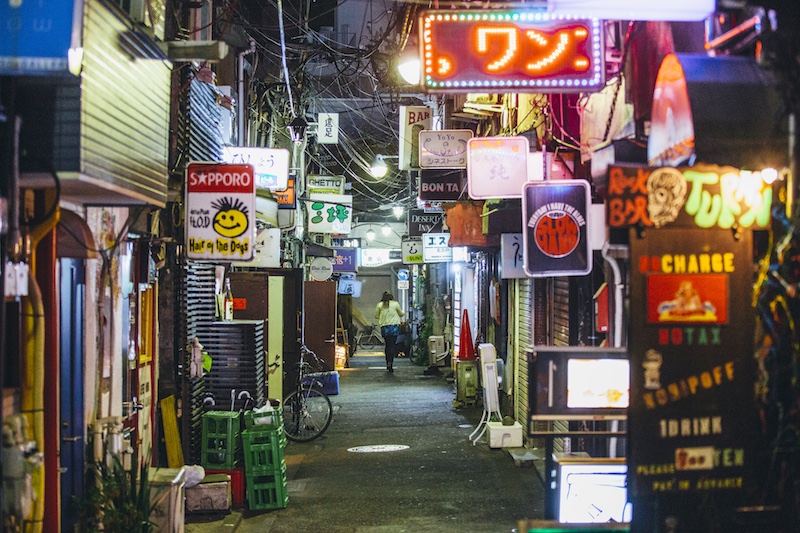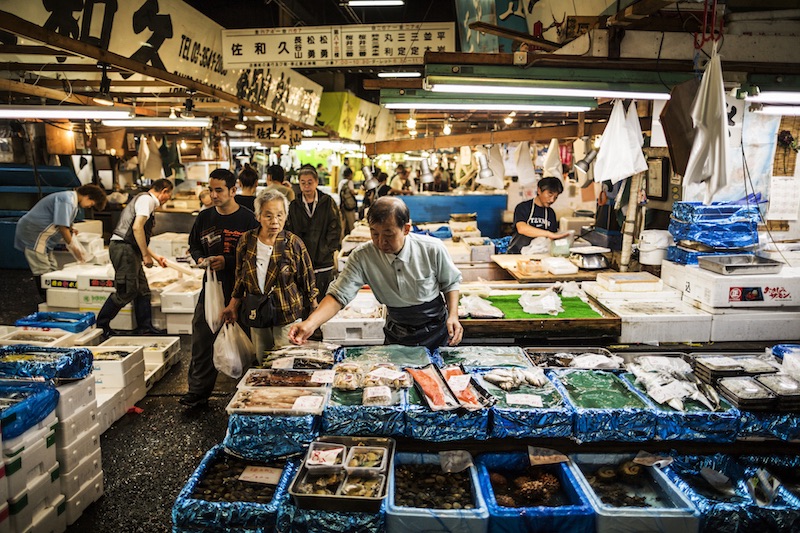10 Must Try Eating and Drinking Experiences in Tokyo

With more than 100,000 restaurants and eating and drinking opportunities stretching from traditional Japanese flavours to inventive and ground-breaking fine dining, Tokyo is one of the world's greatest food cities. Here's our guide to all the delicious and diverse things Tokyo has to offer.
(Be sure to book a few months ahead for the higher end places).

There's an amazing place to eat around every corner in Tokyo (photo: Getty Images).
Den - Shibuya
Two Michelin stars and a standout position on San Pellegrino's World's 50 Best Restaurants roster make Den a dining appointment for savvy travelling foodies. The menu focuses on modern kaiseki cuisine, incorporating a series of smaller flavour-packed dishes, with the seasonal eight-course degustation option including Den's signature dish of a simple 'garden salad' incorporating 20 different raw and cooked vegetables. Chef Zaiyu Hasegawa's playful humour is also evident with his 'Den-tucky fried chicken' served in a lookalike KFC cardboard box, where he takes the dish to a whole new level.
Narisawa - Aoyama

The gastronomical brilliance of Narisawa's snow crab Christmas wreath (photo: City Foodsters/Flickr)
Florilège - Shibuya
Tokyo's dining scene boasts more Michelin stars than any other city on the planet, and two-starred Florilège is a sophisticated testament to the city's attraction to French cuisine. Japanese and French ingredients are harnessed for chef Hiroyasu Kawate's cosmopolitan menu, resulting in imaginative fusion dishes such as pigeon-stuffed manju dumplings simmered in port wine. Absolutely delicious.
Irifune - Setagaya
Ask a Tokyo local where to go for sushi and there's a good chance they'll recommend this restaurant, which serves only the freshest of tuna. Vendors at the city's famed fish market reserve their finest Majuro (blue-fin) tuna for Katsumi Honda, Irifune's octogenarian owner and chef. He uses the famous fish in simple but clever ways in a variety of dishes. The recommended form is to order the multi-course omakase menu, and let the chef serve you whatever is best and freshest on the day. Be sure to visit the fish market too.

Tokyo's Tsukiji Fish market has some of the best seafood in the world (photo: Getty Images).
Tsunahachi - Shinjuku
Sweep open the noren (traditional curtains) at Tsunahachi's discreet entrance to discover one of Tokyo's finest tempura restaurants. First opened in 1923, the Shinjuku eatery specialises in seafood and vegetables cooked to order in a delicate tempura batter. Secure a seat at the counter and watch the skilled action from the chefs, who are masters at their trade. For the full Tsunahachi experience, go for the ten-dish tasting menu including fried prawns, eel and shellfish.
Afuri - Ebisu/Shinjuku/Shibuya
You'll find traditional ramen noodle shops on every corner in Tokyo, but it's worth catching the JR Yamanote subway line southwest to Afuri in the Ebisu neighbourhood. Hip young chefs combine with a stylish industrial interior, and there are a few surprises on the menu as well. Try the yuzu-shio ramen, a soothing and hearty bowl of egg noodles enlivened with a zingy hit of yuzu (a Japanese citrus fruit). Afuri's Ebisu address is the original, but they've also opened stores in Tokyo's Shinjuku and Shibuya neighbourhoods too, and they're almost as good.

For the best traditional ramen in the city visit Afuri (photo: bethom33/Flickr).
Eatrip
In a surprisingly leafy oasis tucked away just off a busy thoroughfare in Harajuku, dining at Eatrip is like spending time at a foodie friend's private home. Owner Yuri Nomura sources organic and sustainable ingredients from farms in the greater Tokyo area, and the relaxed Japanese-Scandinavian décor showcases dishes delivered with a light Mediterranean touch. Natural and biodynamic wines partner always seasonal menus, often with an emphasis on vibrant vegetarian flavours.
Out – Shibuya
Possibly Tokyo's most minimalist eatery, Out is an ode to the simple pleasures of perfect pasta, fine red wine and rock n roll. Every night Out's focused menu combines a single variation of handmade pasta and fresh truffles with an excellent red wine, strictly soundtracked by Led Zeppelin on vintage vinyl.
Ushitora – Shimokitazawa
With hoppy brew bars dotting laneways across the city, craft beer is making waves in the Japanese capital. Serving only Japanese beers, Ushitora in the Shimokitazawa neighbourhood is spread across two adjacent locations and showcases Ushitora's own brews and also beers from other smaller Japanese craft breweries. Park yourself at the tachinomi (standing bar) and partner moreish kushiage (skewers of grilled meat and vegetables) with standout beers such as the Yabai Double IPA.

Ushitora has all the best beers in a unique Tokyo setting (photo: Shinya ICHINOHE/Flickr).
Moto - Shinjuku
Another intimate 'standing bar', Moto in Shinjuku is a brilliant place to delve into the fascinating world of sake (Japanese rice wine). Many of the sakes come from smaller, artisan producers, and with room for only 12 guests, Moto is an intimate experience. The friendly bar staff are adept at guiding newbies through the list of more than 60 options, and can also recommend which sakes to partner with Japanese-style bar snacks including karaage fried chicken and tuna tartare.

one of a kind holiday?
Takes 3 minutes
